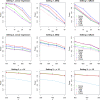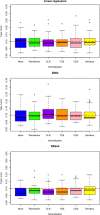Accommodating multiple potential normalizations in microbiome associations studies
- PMID: 36658484
- PMCID: PMC9850542
- DOI: 10.1186/s12859-023-05147-w
Accommodating multiple potential normalizations in microbiome associations studies
Abstract
Microbial communities are known to be closely related to many diseases, such as obesity and HIV, and it is of interest to identify differentially abundant microbial species between two or more environments. Since the abundances or counts of microbial species usually have different scales and suffer from zero-inflation or over-dispersion, normalization is a critical step before conducting differential abundance analysis. Several normalization approaches have been proposed, but it is difficult to optimize the characterization of the true relationship between taxa and interesting outcomes. RESULTS: To avoid the challenge of picking an optimal normalization and accommodate the advantages of several normalization strategies, we propose an omnibus approach. Our approach is based on a Cauchy combination test, which is flexible and powerful by aggregating individual p values. We also consider a truncated test statistic to prevent substantial power loss. We experiment with a basic linear regression model as well as recently proposed powerful association tests for microbiome data and compare the performance of the omnibus approach with individual normalization approaches. Experimental results show that, regardless of simulation settings, the new approach exhibits power that is close to the best normalization strategy, while controling the type I error well. CONCLUSIONS: The proposed omnibus test releases researchers from choosing among various normalization methods and it is an aggregated method that provides the powerful result to the underlying optimal normalization, which requires tedious trial and error. While the power may not exceed the best normalization, it is always much better than using a poor choice of normalization.
Keywords: Cauchy combination test; Different library size; Normalization; Omnibus approach.
© 2023. The Author(s).
Conflict of interest statement
The authors declare that they have no competing interests.
Figures
References
-
- Turnbaugh PJ, Ley RE, Mahowald MA, Magrini V, Mardis ER, Gordon JI. An obesity-associated gut microbiome with increased capacity for energy harvest. Nature. 2006;444(7122):1027–1031. - PubMed
-
- John GK, Mullin GE. The gut microbiome and obesity. Curr Oncol Rep. 2016;18(7):1–7. - PubMed
-
- Maruvada P, Leone V, Kaplan LM, Chang EB. The human microbiome and obesity: moving beyond associations. Cell Host Microbe. 2017;22(5):589–599. - PubMed
-
- Hartstra AV, Bouter KE, Bäckhed F, Nieuwdorp M. Insights into the role of the microbiome in obesity and type 2 diabetes. Diabetes Care. 2015;38(1):159–165. - PubMed
-
- Komaroff AL. The microbiome and risk for obesity and diabetes. JAMA. 2017;317(4):355–356. - PubMed
MeSH terms
Grants and funding
LinkOut - more resources
Full Text Sources




